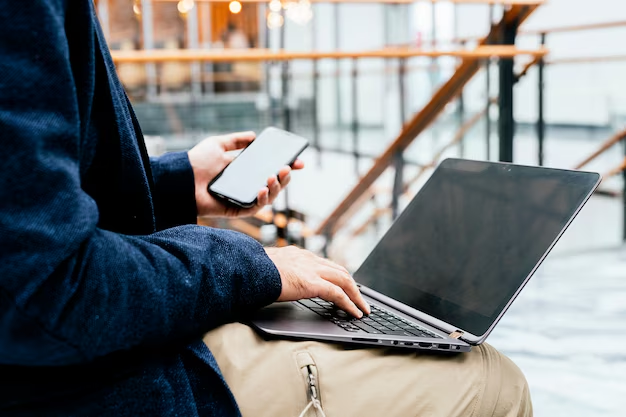Seamlessly Transfer Photos from Your Phone to Your Laptop Wirelessly
In today's digital age, capturing moments with our smartphones is second nature. Yet, transferring these cherished photos to a laptop for backup or editing often seems cumbersome. While connecting devices via a USB cable works, the modern age offers us better solutions: wireless transfers. Let's explore how to efficiently transfer photos from your phone to your laptop without a single cable, ensuring your memories are safely stored and easily accessible.
Why Transfer Photos Wirelessly?
Before diving into the 'how,' let's understand why you might choose to transfer photos wirelessly:
- Convenience: Forget cables and adapters. With wireless transfers, you can move files anytime, anywhere.
- Versatility: No need for different cables for different devices.
- Efficiency: Transfer hundreds or thousands of photos in mere minutes.
- Flexibility: Many phones and laptops now have apps or built-in methods to facilitate a seamless transfer process.
Now that you're primed with the benefits, let's dive into the various options available for wirelessly transferring photos from your phone to your laptop.
The Two Main Players: Operating System Specific Solutions
iOS to macOS
Owning an iPhone and a MacBook? Apple makes this process exceptionally simple.
AirDrop
Apple's AirDrop feature is one of the most convenient ways to transfer photos.
Activate AirDrop: On your iPhone, swipe down from the right corner of the screen to access the Control Center. Press and hold the network settings card and tap AirDrop. Set it to "Contacts Only" or "Everyone."
Open Photos: Open the Photos app and select the photo(s) you want to transfer.
Share via AirDrop: Tap the share icon, then hit AirDrop and choose your MacBook from the list of devices.
Confirm Transfer: On your Mac, accept the files, and in seconds they’ll be on your hard drive.
iCloud Photos
Using iCloud ensures your photos are always synced across devices.
Enable iCloud Photos: On your iPhone, go to Settings > [your name] > iCloud > Photos, and turn on iCloud Photos.
Access on Mac: Open the Photos app on your Mac, and with the same Apple ID, your photos appear automatically.
Android to Windows
Google Photos
Google Photos offers a hassle-free way to access photos across multiple devices.
Backup on Google Photos: Install the Google Photos app on your Android phone. Sign in with your Google account, go to Settings > Backup & sync, and turn it on.
Access on Windows: Visit photos.google.com in any web browser on your laptop. Log into your Google account, and access/download your backed-up photos.
Your Phone App
For Samsung and other compatible devices, the Your Phone app on Windows is brilliant.
Setup Your Phone Companion: Download 'Your Phone Companion' app on your Android device. Connect it with Windows using the app to establish the sync.
Transfer Files: Once linked, drag and drop photos, or select them to copy over to your PC.
Cross-Platform Solutions
Cloud Storage Services
Dropbox
- Upload photos using the Dropbox app or website on your phone.
- Access and download these photos from the Dropbox client or website on your laptop.
OneDrive
- Save your photos on OneDrive using its mobile app.
- Access them easily on your laptop with the OneDrive app or through the browser.
Bluetooth
An old but reliable method, provided your devices support it.
Pair Devices: Turn on Bluetooth on both the phone and laptop, pair them up.
Sharing: Use your phone's Bluetooth options to send photos to your laptop.
Third-party Apps
Several apps can bridge the gap between operating systems, some popular choices include:
- Snapdrop: Works like AirDrop but for all devices. Open it in your browser on both devices, select files, and transfer.
- Send Anywhere: Upload your desired photos, and it provides a link or key to download them on your laptop.
Practical Tips for Smoother Photo Transfers
To ensure you have the best experience with wireless transfers, consider these tips:
- 🌐 Stable Internet Connection: For cloud transfers, a steady Wi-Fi connection ensures speed and reliability.
- 🔋 Battery Check: Wireless transfers can consume battery. Make sure your devices are charged.
- 📁 Organize before Transfer: Having an organized album setup can streamline the transfer process.
- ⌛ Regular Backups: Regular backups prevent data loss and keep your photos safe.
A Visual Guide: Your Handy Transfer Summary
Here’s a quick rundown to guide your choice:
| Method | Best For | Requirements |
|---|---|---|
| AirDrop | iPhone to Mac | iPhone & Mac in proximity, Wi-Fi/Bluetooth enabled |
| iCloud Photos | Automated Sync | iCloud storage space, Apple ID |
| Google Photos | Cross-device access | Google account, ample storage space |
| Your Phone App | Samsung/Android to Windows | Windows 10+, linked Microsoft/Google account |
| Dropbox/OneDrive | Cross-platform syncing | Account for service, apps installed |
| Bluetooth | Short distance transfers | Bluetooth-enabled devices |
| Snapdrop/Send Anywhere | Quick, universal file sharing | Browsers/app installed, internet access |
Having these strategies at your fingertips offers versatility, whether you're a fan of Apple's seamless integration, Google's expansive reach, or prefer independent third-party solutions. Remember, the best method often depends on your specific devices and personal preferences. Ultimately, your choice will enhance how effortlessly you share memories across devices, ensuring they remain accessible, organized, and secure.

Related Topics
- How Can I Transfer Contacts To My New Phone
- How Can I Transfer Music From My Ipod To Computer
- How Can I Transfer My Contacts To Another Phone
- How Can I Transfer Photos From Camera To Computer
- How Can You Transfer Text Messages To a New Phone
- How Do I Transfer Apps To My New Phone
- How Do I Transfer Contacts From One Phone To Another
- How Do I Transfer My Contacts To Another Phone
- How Do I Transfer My Contacts To My New Phone
- How Do I Transfer Phone Contacts To New Phone